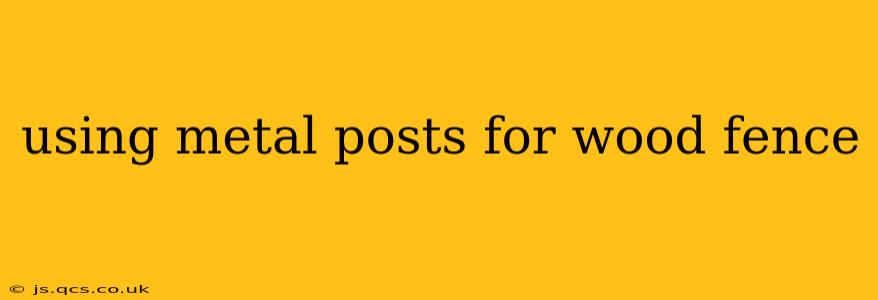Building a wood fence is a rewarding DIY project, but choosing the right posts is crucial for longevity and stability. Metal posts offer several advantages over traditional wood posts, including increased durability, resistance to rot and insects, and a longer lifespan. This guide explores the benefits, installation process, and considerations when using metal posts for your wood fence.
Why Choose Metal Posts for a Wood Fence?
Metal fence posts, typically made of steel or aluminum, provide a robust foundation for your wood fence. Here's why they're a popular choice:
- Durability: Metal posts are significantly stronger and more resistant to damage from impacts, rot, and insect infestations compared to wood. They can withstand harsh weather conditions and maintain their structural integrity for many years.
- Longevity: Unlike wood, metal posts won't rot or decay, extending the lifespan of your entire fence. This translates to less maintenance and fewer replacements over time, saving you money in the long run.
- Pest Resistance: Metal posts are impervious to termites, carpenter ants, and other wood-boring insects that can weaken and destroy wooden posts.
- Straightness and Stability: Metal posts are manufactured to precise dimensions, ensuring straight lines and a stable fence. This is especially important for longer fence runs.
- Ease of Installation (in some cases): Depending on the type of post and soil conditions, metal posts can be easier to install than wooden ones, especially with the use of specialized post drivers.
What Types of Metal Posts are Available?
Several types of metal posts cater to different needs and budgets:
- Steel Posts: These are the most common and durable option, offering excellent strength and longevity. They are usually galvanized or powder-coated for extra protection against rust.
- Aluminum Posts: Lighter than steel, aluminum posts are more resistant to corrosion and require less maintenance. They are a good choice in coastal areas or regions with high humidity.
- Different Shapes & Sizes: Metal posts come in various shapes (round, square, T-posts) and sizes (diameter and length) to suit different fence heights and soil conditions.
How to Install Metal Posts for a Wood Fence?
The installation process generally involves these steps:
- Planning & Layout: Determine the fence line, post spacing (typically 6-8 feet apart), and post depths.
- Digging Holes: Use a post hole digger to create holes of the appropriate depth and diameter. The depth will depend on your local frost line and post height.
- Setting the Posts: Place the metal posts in the holes, ensuring they are plumb (perfectly vertical) using a level. You might need to add gravel or concrete to stabilize the posts.
- Backfilling: Backfill the holes with compacted soil, gravel, or a concrete mix to secure the posts firmly in place.
- Attaching the Fence: Once the posts are set and the concrete has cured (if used), attach the fence rails and boards to the posts using appropriate hardware.
What size post hole do I need for metal fence posts?
The size of the post hole depends on the post diameter, soil type, and local building codes. It's generally recommended to have a hole diameter at least 1.5 times larger than the post. Depth should account for local frost lines to prevent heave. Consult local building regulations and professionals for specific recommendations.
How deep should metal fence posts be set?
The depth of metal fence post installation should be at least one-third of the post's above-ground height, and in many areas it should extend below the local frost line to prevent the posts from moving due to frost heave. This usually ranges from 2-4 feet deep, but local codes might require deeper settings.
What is the best way to set metal fence posts in hard ground?
Setting metal fence posts in hard ground can be challenging. A post hole digger might not suffice. You can use a post hole auger, a powerful drill attachment, or even consider renting a professional post driver. For particularly hard ground, consider adding gravel to improve drainage and aid in compaction.
What type of concrete should I use for metal fence posts?
A quick-setting concrete mix designed for outdoor use is recommended for setting metal fence posts. This ensures a strong and durable foundation. Make sure to mix the concrete according to the manufacturer’s instructions.
Maintaining Your Metal Post Fence
While metal posts require less maintenance than wood, regular inspections are recommended. Check for any signs of damage or rust, and address these promptly to prevent further deterioration. A fresh coat of paint or protective sealant can extend the life of the posts, particularly in harsh environments.
By choosing metal posts, you're investing in a durable and long-lasting fence that requires minimal upkeep. While the initial cost might be slightly higher than wood, the long-term savings and reduced maintenance make them a worthwhile investment for many homeowners. Remember to always consult local building codes and consider seeking professional assistance if you're unsure about any aspect of the installation process.
